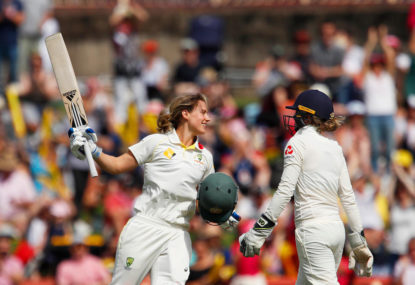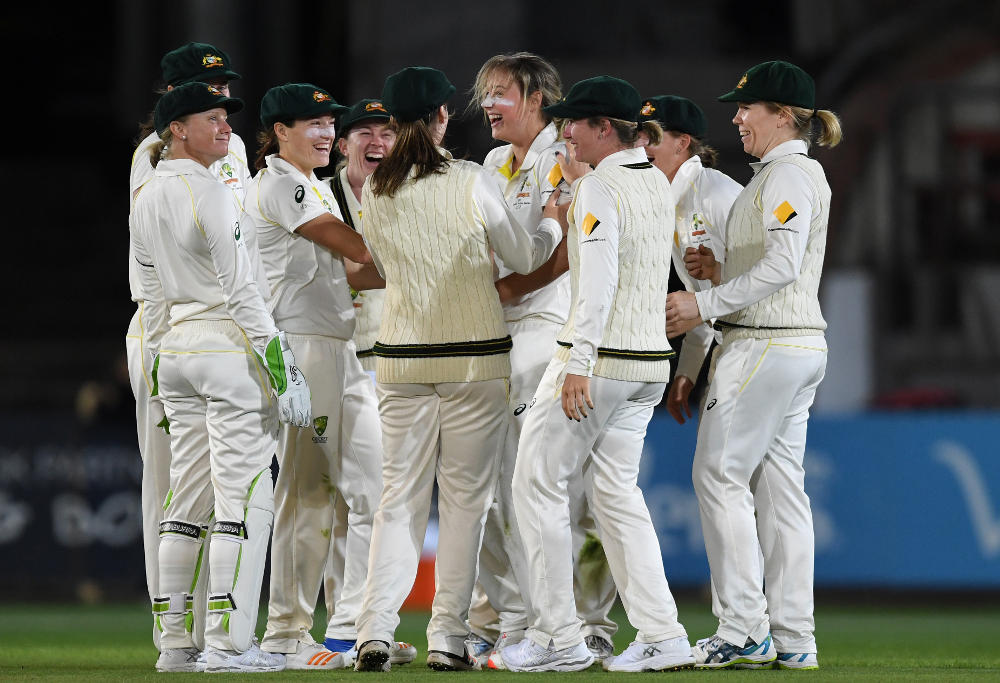Ruthless Aussies thrash Bangladesh by eight wickets, secure ODI series clean sweep
A ruthless Australian women's cricket team has shown little mercy to Bangladesh, thumping the hosts by eight wickets to clean sweep their ODI series.…

The Ashes. Australia versus England on the cricket pitch in one of world sport’s greatest rivalries. While the men have had the limelight for 135 years, the women have struggled for recognition. But slowly that is changing.
While in decades past the likes of Betty Wilson, Lyn Larsen and Belinda Clark practised their art in relative obscurity, rarely watched by more than two men and a dog, the profile of women’s cricket is growing.
Shorter forms of cricket like T20 have made men’s and women’s double-headers feasible. TV multi-channelling and web streaming have opened up media coverage never previously imaginable.
There’s nowhere near as money as the men’s game, but that there is any money at all is a step in the right direction from where the game was previously.
The women’s Ashes is determined by a points system from all three forms of the game. The only Test in this summer’s series took place this weekend.
One thing the organisers did right was to schedule the game for North Sydney Oval. The ground is far removed from the modern-day stadium. Corporate facilities are non-existent other than a demountable marquee set up on the hill. The grandstands are decked out in brown seats with cream cladding and green roofs. A fig tree leans over the northern sightscreen. Much of the crowd were sprawled on picnic rugs on the hill. It was a very pleasant backdrop.
Another thing they got right was to play this game under lights, the first Ashes Test ever to be played with a pink ball. And as the sun set and the lights took over, the pink ball was well visible. On the first two days the crowd swelled in the evening session as nearby workers downed tools and made their way to the ground.

(Photo by Mark Kolbe/Getty Images)
Saturday was the third day and started with the match delicately poised. England had been dismissed for 280 and Australia were 5 for 177. Ellyse Perry and Alyssa Healy strode to the wicket to continue the innings. Perry had batted through some carnage the night before to resume on 70, while Healy was on one. It had been slow going on the second day, but as Perry hit two boundaries in the second over of the third day it was clear the Aussies meant business.
Healy, a wicketkeeper and handy with the bat like her uncle Ian, was in the mood to push the scoring rate along as she cleared two balls over the boundary rope. But Perry was the standout as she played her way beyond the 100 mark, raising her bat to generous applause from the ground as the milestone was passed.
By the time the tea break came, Australia had passed England’s total. Alyssa Healy went not long before the break, top-edging the ball as it went up for a simple catch. Debutant Talia McGrath joined Perry.
The sun alternated between hiding behind white clouds and popping its head out for a better view of the action. The crowd sat enthralled, many of them wearing pink as part of a McGrath Foundation breast cancer fundraiser. Pink bandanas, sombreros and other merchandise were moving as quickly as the sales staff could lap the ground.
But it was another McGrath, young Talia, who was attracting attention. Far from a tail-ender, she was taking the game up to the tiring England bowlers and matching it with Perry in a partnership that went well over 100 runs before McGrath holed out to the outfield to depart for 47.
But Ellyse Perry was still there, and this was her day. In terms of building support for women’s sport, she’s a marketer’s dream. Well-spoken and talented, she plays football well, and cricket even better. As the players left the field for the 40-minute dinner break, records were within sight.
Admission was $10, and for children it was free – and there were plenty of kids there, boys and girls, and no shortage of players from both teams willing to sign their autograph books and bats. The signatures of the likes of Alex Blackwell, Rachael Haynes and Alyssa Healy were just as treasured as the pre-existing squiggles of the ilk of Steve Smith, David Warner and Mitchell Starc.
Two more wickets fell early in the last session, and Perry was joined by number 11 Megan Schutt. But Schutt didn’t let her down, playing a straight bat and turning over the strike.
Perry was on 194 as she picked up a half-volley and drove it high and straight. Either just over or marginally short of the rope. Perry celebrated, raising her bat to the crowd thinking she’d brought up her double century. But it was a false milestone, replays showing the ball hadn’t cleared the rope. No double century yet.
But after the anti-climactic call, the real double century came in the next over, and then it was time to swing the bat, with another four and a six taking her to 213, the highest score ever by an Australian in a women’s Test.
And with the milestone came the declaration, giving the Aussies a score of 448, a first-innings lead of 168.
The crowd had built up to 3,932, each day’s crowd bigger than that of the day before. A long day in the sun had started to take its toll, and the crowd noticeably thinned during the innings break, but there were still plenty of fans who stuck around to see Australia bowl for an hour.
A small group next to the Bob Stand after a long day on the amber fluids found their voice, serenading the game with renditions of “Ooh. Ah. Talia McGrath” and “Walking in a Perry Wonderland”.

(AAP Image/Dean Lewins)
The England openers made it through to stumps, but it had been Australia’s day, and every one of them, even the undoubtedly exhausted Perry, stuck around for an autograph and selfie session after stumps.
Women’s cricket has its critics. Some say the standard isn’t great. But it’s picking up as players get access to professional facilities. Without the time and money of full-time professionalism that the men get, there are constraints on how and when they can train when players have to also hold down jobs.
Some say it’s slow, but they don’t play a lot of Test cricket. And the scoring rate on Saturday wasn’t too bad – more than 300 runs were scored.
Before men’s cricket went full-time professional, run rates rarely exceeded three runs per over. Warner-type scoring in Test cricket is a relatively recent thing. Even teams like Ian Chappell’s invincibles of the 1970s and the unbeatable West Indies teams of the 1980s struggled to score 250 runs in a day.
And one thing the men could definitely learn from the women is managing their over rates. Six hours of play saw 100 overs bowled. The men, even with an extra half hour, rarely complete 90. Just one drinks break per session. The pace bowlers had run-ups, but they weren’t excessive. They quickly changed ends between overs and got on with the game. That was refreshing to see.
It was an enjoyable day of cricket and another step in the path of growing women’s cricket – and we’ll see more of our Southern Stars in the weeks to come as the Women’s Big Bash League hits our TV screens. I for one am looking forward to seeing it.